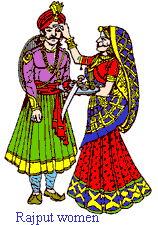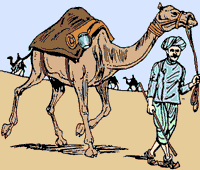
Dimdima
Online Children's Magazine from India

Dimdima
Online Children's Magazine from India
Rajasthan meaning “The Land of the Rajas”, was formerly called Rajputana, “The Country of the Rajputs”.
It was after 1947 that Rajasthan came into being with the integration of the princely states in stages and finally assumed its present form on November 1st, 1956, with the States’ Reorganization Act.
Area : 342.239 square kilometres
Population : 5,64,73,122. The people who have inhabited this region for long include the Minas, the Meos, the Banjara, who are travelling tradesmen and artisans; the Bhils, one of the oldest peoples in India, and the Rabans of Marwar who are cattle breeders. The Rajputs, famed in legend, represent only a small percentage of the population.
Main Language : The principal language spoken is Rajasthani.
Capital : Jaipur.
Location :
The state located in India’s northwest, is bounded on the west by Pakistan, on the north and the northeast by Punjab. Haryana, and Uttar Pradesh, on the east and southeast by Uttar Pradesh and Madhya Pradesh, and on the southwest by Gujarat.
Physiography :
The Aravalli mountain range divides the state into two regions. To the northwest is the Thar desert; the southeastern part has hill ranges, fertile table lands and dense forests.
Economy :
Rajasthan is mainly an agricultural and pastoral state. Despite a low and erratic rainfall, wheat and barley are cultivated in large areas, as are pulses, sugarcane, and oilseeds. Cotton and tobacco are important cash crops. Rajasthan is also India’s largest wool-producing state.
Rajasthan receives water for irrigation from the Punjab rivers and from several hydroelectric projects in the neighbouring states. The Indira Gandhi Canal that carries water over 350 kilometres from the Beas and Sutlej rivers in Punjab has helped irrigate desert land in western Rajasthan.
Rajasthan produces India’s entire output of lead and zinc, emeralds and garnets. Kota is the industrial capital of the state.
Climate :
Summers in Rajasthan are hot, characterized by hot winds and dust storms especially in the desert. Winter temperatures vary from 20 C to 24.50 C. The winter of 1999-2000 will go down in Rajasthan history as one of the most severe. It was so cold that snow fell in parts of Jaipur. The western desert has little rain but in the southeast, rainfall is higher.
In the 3rd century BC, Rajasthan formed a part of Ashoka's empire. Later rulers included the Bactrians, the Scythians, the Guptas, and Harshavardhana in the 7th century AD.
Between the 7th and 11th centuries several Rajput dynasties rose, including that of the Gurjara-Pratiharas. Under Bhoja I (836-885), their territory stretched from the Himalayan foothills to the Narmada and from the middle Ganges Valley to Sindh. After them, several rival Rajput clans like the Guhilas, asserted their independence in the 10th century and established control of the region around Mewar. By the 11th century the Chauhans with their capital at Ajmer and later Delhi, had emerged as a major power. In the following centuries, other clans, such as the Kachwahas, Bhattis, and Rathors, succeeded in establishing independent kingdoms for a brief period.
Rana Sangram of Mewar was defeated by the Mughal invader, Babur. It is largely from this period of Rajasthan's history that the romantic view of the Rajput as a valiant warrior, defending family and honour against invaders is derived.
In the 16th century the Mughal emperor Akbar tried to subdue the Rajputs through diplomacy and military action. While the strongholds of Ranthambore and Chittor were besieged and destroyed, other Rajput ruling houses were won over when Akbar married their princesses and appointed their nobles to important positions in the Mughal army. The practice of contracting matrimonial alliances with the Rajputs continued after Akbar, and both the emperors, Jahangir and Shah Jahan had Rajput mothers. Some Rajput rulers such as Man Singh of Amber and Jaswant Singh of Marwar served with distinction in the Mughal army.
After the death of the emperor Aurangzeb the state of Bharatpur was established by the Jats but Maratha influence became strong in the region. When Maratha power began to decline towards the middle of the 18th century, the British stepped in. The British allowed the rulers of the various Rajput states to govern their territories but a British representative controlled external affairs.
During the freedom struggle Ajmer became the centre of political activity. After independence, the Rajput princes gradually surrendered their powers to the central government and the state of Rajasthan came into being.
Rajasthan offers a virtual feast for the eyes, as it abounds in objects of historical interest. The 300-year-old seat of the Mewar Rajput kingdom, Udaipur, nestles in a scenic valley, ringed by three lakes -Pichola, Fateh Sagar and Udai Sagar. The fabulous hotel, the Lake Palace of Udaipur was the summer residence of the former rulers.
The most famous landmark of Jaipur, the capital is the five-storeyed Hawa Mahal. Mount Abu is a popular hill station. Between the 11th and the 13th centuries, some of India's most spectacular marble temples were built here, at Dilwara.
Bharatpur is popular for its bird sanctuary-the Keoladeo Ghana National Park. Chittor echoes with tales of romance and valour. The Chittorgarh fort with its many gateways was built in the 7th century A.D. The 37-metre high Vijay Stambh, built in 1440 is covered with exquisite sculptures of Hindu deities and episodes from the Ramayana and Mahabharata.
Arising from the heart of the Thar desert is Jaisalmer. A magnificent fort etched in yellow sandstone dominates the city. The fort houses the entire township within its ramparts. With its enchanting cob-web of narrow lanes dotted with lovely havelis, the fort has three beautifully sculptured Jain temples of the 12th-13th centuries and five inter-connected palaces.
Jodhpur was founded by Rao Jodha. Its Mehrangarh Fort is 5 km long and built atop a 125-m high hill. The Umaid Bhavan Palace which has 347 rooms, was once one of the largest private residences in the world.
Pushkar is a pilgrimage centre. India's only temple dedicated to Brahma is located here. A religious and livestock fair draws millions to it annually. Deep in the forests of Ranakpur, is the 15th century Adinatha Temple, the largest Jain temple in India.
A well-known folk dance of Rajasthan is the ghoomar, performed on festive occasions by women. The geer (performed by men and women), the panihari (a graceful dance for women), and the kacchi ghori (in which male dancers ride dummy horses) are also popular.



Dimdima is the Sanskrit word for ‘drumbeat’. In olden days, victory in battle was heralded by the beat of drums or any important news to be conveyed to the people used to be accompanied with drumbeats.
Bharatiya Vidya Bhavan
K. M Munshi Marg,
Chowpatty, Mumbai - 400 007
email : editor@dimdima.com
Bharatiya Vidya Bhavan
505, Sane Guruji Marg,
Tardeo, Mumbai - 400 034
email : promo@dimdima.com
Dimdima.com, the Children's Website of Bharatiya Vidya Bhavan launched in 2000 and came out with a Printed version of Dimdima Magazine in 2004. At present the Printed Version have more than 35,000 subscribers from India and Abroad.